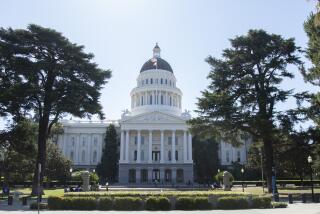Does Laming the Legislature Upset the Constitution? : The legal view: This shift in the balance of power may go beyond the authority of initiatives.
- Share via
Proposition 140 will accomplish a huge shift in the balance of political power in Sacramento. Term limits will mean business as usual for the executive branch. Throughout California’s history, only Gov. Earl Warren served more than two terms. The Legislature, however, has seen a succession of leaders whose power emanates from longevity.
It is highly unlikely that first-term senators, or even second-term Assembly members, will be selected Assembly Speaker or president pro tem of the Senate, or even be appointed to chair key committees. The effect of the term limits is that we will see a succession of Assembly speakers every two years, with every Speaker being a “lame duck” from day one.
Since term limits are prospective, Gov.-elect Pete Wilson, if he serves two terms, may have to deal with Willie Brown and David Roberti for six more years. But future governors will see a regular change of legislative leadership every two years.
This fundamental shift of power offers the strongest constitutional challenge to the validity of Proposition 140. While the initiative was sold as a check on the entrenched power of political incumbency, the real agenda was a shift of political power away from the legislative branch and into the executive branch.
Clearly, the electorate is free to accomplish such fundamental shifts by changing the Constitution. The real issue, however, is whether such changes can be achieved by initiative, as opposed to a constitutional convention or a legislatively approved proposal.
The state Constitution originally provided two methods for change: a convention of delegates to revise it, or a proposal enacted by both houses of the Legislature to amend it. Either method required a vote of the people in favor of the constitutional change. But the distinction between revision and amendment reflected a preference for greater deliberation before truly fundamental changes were enacted.
When the power of the initiative was added to our state Constitution in 1911, the distinction between a revision and an amendment was preserved. Gov. Hiram Johnson’s measure provided that initiatives could only amend the Constitution, still reserving the power to revise to a constitutional convention. Johnson was very familiar with the distinction. He served as co-counsel with his father in an 1893 case in which they successfully argued that a constitutional change should be struck down because it was so fundamental it amounted to a revision. The proposal would have established a commission with the power to move the state capital from Sacramento to San Jose. That case is still the leading state Supreme Court precedent.
In 1966, the power to revise the Constitution was extended to legislative proposals. Thus, only initiative measures are now precluded from revision of the Constitution. Only initiative proposals go directly on the ballot without an opportunity for public debate and correction of drafting flaws. Proposition 140 has its share of flaws. The measure, for example, leaves out the new office of insurance commissioner from its term-limit provisions.
In 1978, despite upholding Proposition 13, the California Supreme Court recognized that “even a relatively simple enactment may accomplish such far-reaching changes in the nature of our basic governmental plan as to amount to a revision.” Thus, the length or complexity of a measure does not determine whether it is a revision or an amendment.
The court is considering a challenge to Proposition 115, the crime initiative adopted by the voters in June, on the grounds that it too is a revision of the Constitution beyond the power of an initiative. The measure also accomplishes a fundamental shift of power, stripping state courts of the authority to construe state constitutional rights more expansively than the federal courts construe the federal Constitution. A decision is likely before the end of the year, and the case will be closely watched for its potential impact on Proposition 140.
But even if the challenge to Proposition 115 succeeds, the decision may not help the legislative leadership. The fundamental changes wrought by Proposition 115 are a direct and immediate result of changes in the language of the Constitution itself. The changes wrought by Proposition 140 will play themselves out as more subtle and gradual shifts of power.
However subtle and gradual, Proposition 140 will mark an important change in the relationship between future governors and legislative leaders. Despite the bashing of the current legislative leadership, the long-term implications of this fundamental shift were barely discussed during the campaign. That’s one of the problems with initiative measures. The real issues tend to get lost in the sound bites and slogans.
More to Read
Get the L.A. Times Politics newsletter
Deeply reported insights into legislation, politics and policy from Sacramento, Washington and beyond. In your inbox twice per week.
You may occasionally receive promotional content from the Los Angeles Times.










